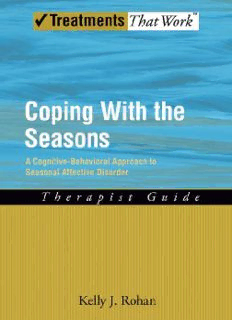
Coping with the Seasons: A Cognitive Behavioral Approach to Seasonal Affective Disorder, Therapist Guide PDF
Preview Coping with the Seasons: A Cognitive Behavioral Approach to Seasonal Affective Disorder, Therapist Guide
Coping With the Seasons EDITOR-IN-CHIEF DavidH.Barlow,PhD SCIENTIFIC ADVISORY BOARD AnneMarieAlbano,PhD GillianButler,PhD DavidM.Clark,PhD EdnaB.Foa,PhD PaulJ.Frick,PhD JackM.Gorman,MD KirkHeilbrun,PhD RobertJ.McMahon,PhD PeterE.Nathan,PhD ChristineMaguthNezu,PhD MatthewK.Nock,PhD PaulSalkovskis,PhD BonnieSpring,PhD GailSteketee,PhD JohnR.Weisz,PhD G.TerenceWilson,PhD Coping With the Seasons A COGNITIVE-BEHAVIORAL APPROACH TO SEASONAL AFFECTIVE DISORDER T h e r a p i s t G u i d e Kelly J. Rohan 1 2009 1 OxfordUniversityPress,Inc.,publishesworksthatfurther OxfordUniversity’sobjectiveofexcellence inresearch,scholarship,andeducation. Oxford NewYork Auckland CapeTown DaresSalaam HongKong Karachi KualaLumpur Madrid Melbourne MexicoCity Nairobi NewDelhi Shanghai Taipei Toronto Withofficesin Argentina Austria Brazil Chile CzechRepublic France Greece Guatemala Hungary Italy Japan Poland Portugal Singapore SouthKorea Switzerland Thailand Turkey Ukraine Vietnam Copyright(cid:1)c 2009byOxfordUniversityPress,Inc. PublishedbyOxfordUniversityPress,Inc. 198MadisonAvenue,NewYork,NewYork10016 www.oup.com OxfordisaregisteredtrademarkofOxfordUniversityPress Allrightsreserved.Nopartofthispublicationmaybereproduced, storedinaretrievalsystem,ortransmitted,inanyformorbyanymeans, electronic,mechanical,photocopying,recording,orotherwise, withoutthepriorpermissionofOxfordUniversityPress. LibraryofCongressCataloging-in-PublicationData Rohan,KellyJ. Copingwiththeseasons:acognitive-behavioralapproachtoseasonalaffectivedisorder: therapistguide/KellyJ.Rohan. p. ; cm.—(TreatmentsThatWork) Includesbibliographicalreferences. ISBN978-0-19-534108-9 1.Seasonalaffectivedisorder—Treatment. 2.Cognitivetherapy. I.Title. II.Series:Treatmentsthatwork. [DNLM: 1.SeasonalAffectiveDisorder—therapy. 2.Cognitive Therapy—methods. 3.Psychotherapy,Group—methods.WM171R737c2008] RC545.R642008 616.85(cid:2)27—dc22 2008017766 9 8 7 6 5 4 3 2 1 PrintedintheUnitedStatesofAmerica onacid-freepaper Tomyparents,BettyandJohnF.Rohan,Jr. This page intentionally left blank About TreatmentsThatWorkTM Stunning developments in healthcare have taken place over the last severalyears,butmanyofourwidelyacceptedinterventionsandstrate- gies in mental health and behavioral medicine have been brought into questionbyresearchevidenceasnotonlylackingbenefit,butperhaps, inducing harm. Other strategies have been proven effective using the bestcurrentstandardsofevidence,resultinginbroad-basedrecommen- dations to make these practices more available to the public. Several recent developments are behind this revolution. First, we have arrived at a much deeper understanding of pathology, both psychological and physical, which has led to the development of new, more precisely tar- getedinterventions.Second,ourresearchmethodologieshaveimproved substantially,suchthatwehavereducedthreatstointernalandexternal validity, making the outcomes more directly applicable to clinical sit- uations. Third, governments around the world and healthcare systems andpolicymakershavedecidedthatthequalityofcareshouldimprove, thatitshouldbeevidencebased,andthatitisinthepublic’sinterestto ensurethatthishappens(Barlow,2004;InstituteofMedicine,2001). Of course, the major stumbling block for clinicians everywhere is the accessibility of newly developed evidence-based psychological inter- ventions. Workshops and books can go only so far in acquainting responsible and conscientious practitioners with the latest behavioral healthcare practices and their applicability to individual patients. This newseries,TreatmentsThatWorkTM,isdevotedtocommunicatingthese excitingnewinterventionstocliniciansonthefrontlinesofpractice. Themanualsandworkbooksinthisseriescontainstep-by-stepdetailed procedures for assessing and treating specific problems and diagnoses. vii But this series also goes beyond the books and manuals by provid- ing ancillarymaterialsthat will approximatethe supervisory process in assistingpractitionersintheimplementationoftheseproceduresintheir practice. In our emerging healthcare system, the growing consensus is that evidence-based practice offers the most responsible course of action for the mental health professional. All behavioral healthcare clinicians deeplydesiretoprovidethebestpossiblecarefortheirpatients.Inthis series, our aim is to close the dissemination and information gap and makethatpossible. This therapist guide applies cognitive-behavioral therapy (CBT) for depression to the treatment of seasonal affective disorder (SAD). The prevalence of winter-type SAD is significant, especially at higher lati- tudes; even more common is subsyndromal SAD (S-SAD) or milder “winterblues.”Dr.Rohanprovidesamuch-neededtreatmentforSAD in a complete and accessible package. The therapist guide outlines a 12-sessiongroupprogramtobeconductedover6weeksduringthefall orwinter.Itmayalsobeusedwithindividualclientsorinconjunction withlighttherapy(LT).ParticipantslearneffectiveCBTtechniquesthat will serve them this winter and beyond. The protocol consists of psy- choeducation,behavioralactivation,cognitiverestructuring,andrelapse prevention.Thecorrespondingworkbookfollowstheprogramsession- by-session and provides forms for homework. Specifically tailored for use with the SAD population, clinicians will find this a unique and beneficialprogramfortheirclients. DavidH.Barlow,Editor-in-Chief, TreatmentsThatWorkTM Boston,MA References Barlow, D. H. (2004). Psychological treatments. American Psychologist, 59, 869–878. InstituteofMedicine.(2001).Crossingthequalitychasm:Anewhealthsystem forthe21stcentury.Washington,DC:NationalAcademyPress. viii Acknowledgments First, I would like to acknowledge the contribution of all of the participantsintheSeasonalityTreatmentProgram,formerlyattheUni- formed Services University of the Health Sciences (USUHS) and now at the University of Vermont, who have made this work possible and rewarding. The development of a cognitive-behavioral therapy (CBT) treatment for seasonal affective disorder (SAD) would not have been possiblewithoutdecadesofpriorworkbyothersonthecognitivetheory and therapy of depression and on the behavioral conceptualization of depressionandbehaviortherapy.Forthis,IammostgratefultoAaron T. Beck and his colleagues, particularly Judith S. Beck, in developing the theory and treatment principles that inspired me to modify cogni- tive therapy for SAD and to Peter M. Lewisohn and his colleagues for developingpleasanteventsschedulingasapotentbehavioraltreatment strategy that has proven very useful for SAD. These treatment compo- nentsrepresentmuchofthematerialcontainedwithinthismanual,and theiroriginatorsdeservefullcreditforthem.Iwouldalsoliketothank Alan Peterson for sharing his ideas on basic psychoeducation regard- ing depression symptoms and relapse prevention. I am grateful to my colleagues,DavidA.F.HaagaandTeodorT.Postolache,andtomyfor- merclinicalgraduatestudentsandco-therapists,mostnotablyKathryn A. Roecklein, Kathryn Tierney Lindsey, and Brenda Elliot, who pro- videdhelpfulfeedbackonthecontentofthisprogramatthetimeitwas initially being conceptualized and tested. Thanks also to the National Institute of Mental Health (NIMH) and to the USUHS for funding theclinicaltrialsthathavetestedthisprotocoltodate. ix
Description: